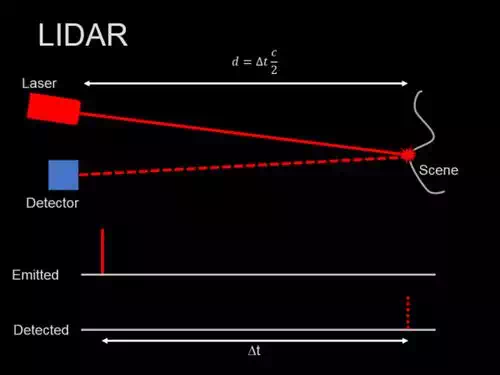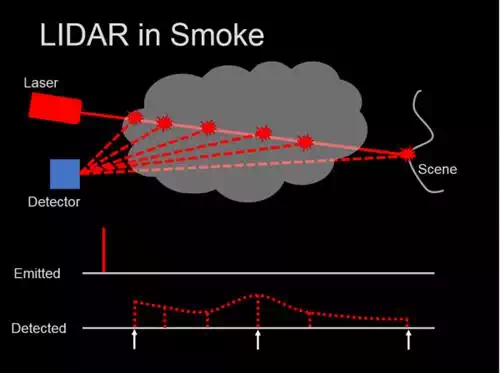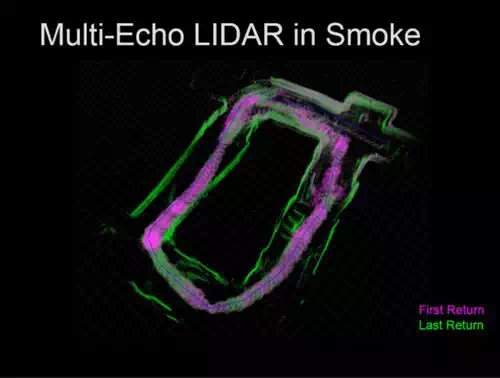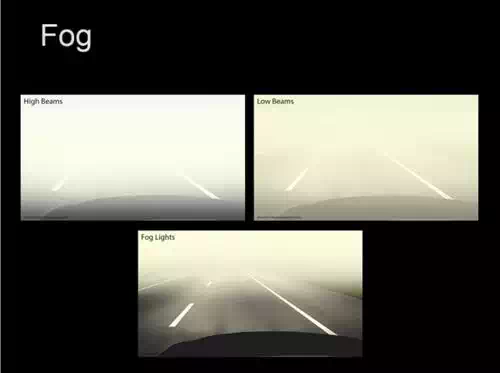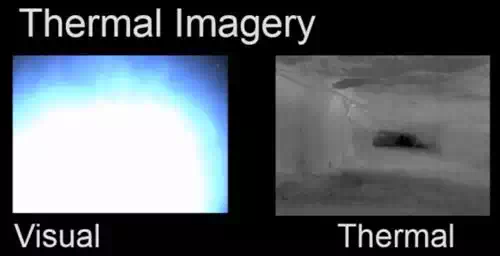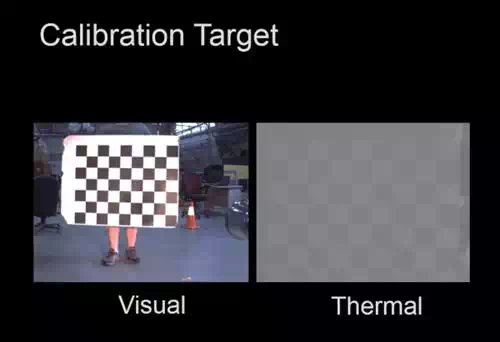Perception in Smoke, Dust or Fog

I recently had the fortune to attend a talk titled Multi-Modal Data for Perception in Smoke-Filled Underground Mines by Joe Bartels. It was an interesting talk about pushing sensor technology into difficult environments that can have smoke, dust or fog . The following are notes that I took during the talk, as always I add a little of my own content to the post. I want to thank Joe for giving the talk and sharing the images that are used below.
LIDAR
Standard LIDAR often fails in smoke, however newer multi echo return LIDAR’s do better.
Standard LIDAR operation showing initial pulse and the returned pulse
LIDAR operation in smoke showing initial pulse and the multiple returned pulse
Point cloud showing LIDAR initial returns and final returns. Note that the initial returns are just a cloud in the center around where the robot drove from the smoke. The final return represents the real structure of the walls, the resolution and quality of the walls is less than if there was no smoke. (Generated with the Hokuyo UTM-30LX-EW)
Sonar & Radar
Sonar and Radar works better
penetrating the smoke, but lacks the resolution of LIDAR. This can be a problem
for creating detailed maps.
Sonar also suffers from a lot of multipath
Cameras
This work was focused in mines where external lighting is required for visual cameras, as opposed to LIDAR/Radar/Sonar which do not need illumination to operate.
Lighting
Typical fog lights are angled downwards at the road to minimize light scattering and minimize having the light reflecting back into the camera. Also the lights should be placed low so that they are far away from the sensor camera.
Road as viewed with different car lighting methods.
The downward light helps illuminate a path on
the ground, but is not high enough for seeing the environment and building a
map (such as for SLAM or data purposes).
Scattered light is not on the
epi-polar lines which interferes with the principles of epi-polar geometry and
stereo reconstruction.
You can add a line filter to the camera which allows only a single line of
light at a time into the camera sensor. This prevents the scattered light from
entering the camera sensor. The downside to this is the reduced data returned
from the camera.
Thermal Cameras
· Thermal cameras often work well and see through smoke. They are based on emissivity (energy emitted from an object) as opposed to the light reflecting from the object (such as with a typical camera).
· Emissivity of 0 would be a mirror, while an emissivity of 1 would be a true blackbody.
· A problem is that the differential response is small in non man-made materials.
· 2 Types of sensors: short wave & long wave. The short wave sensors are more expensive, have better resolution, but less visibility through smoke.
· Lacks the sharp features for many mapping applications
· You need to be careful since lights and people can appear to be similar temperatures
· Wet surfaces can be confusing to interpret
Same image as shown from a visual camera and a thermal camera
Calibrating Thermal Cameras
People often use a standard
calibration target however this is far from ideal
The next step that people often try is to artificially heat/cool a target,
however it is hard to make the target a constant temperature and the
temperature changes are short-lived. When you do this the black will heat up
quickly. When viewed on a thermal camera the checkerboard colors get inverted.
A better way to calibrate thermal cameras is to make a target of dissimilar
materials (multi-modal) that have different thermal properties.
Standard calibration target viewed from visual and thermal cameras
Standard calibration target that is heated viewed from visual and thermal cameras
Calibration target made from a white surface with black circles attached of a different material
“Smoke” Generation
Different
types of smoke/fire produce different perception challenges.
Smoke Candles – White smoke that hangs around. It goes to the
ceiling and then slowly drops down.
Wood Fire – Lighter color smoke that hangs near the top of the
room. Carbon particles are suspended in the air.
Diesel Fire – Dark smoke that sticks to the ceiling and is very
persistent. Carbon particles are suspended in the air.
Dust – Harder than smoke since the particles are bigger, however
the particle suspension time in the air is shorter. Radar tends to be a good
choice in dusty environments.
Fog – Fog is based on small water droplets suspended in the air.
Fog tends to stay lower in the space and not hug the ceiling. Particularly cold
fog stays near the ground, as it heats up it rises before dissipating. This can
be simulated by putting dry ice into hot water.
